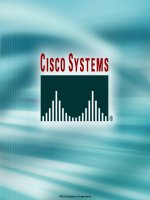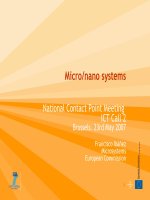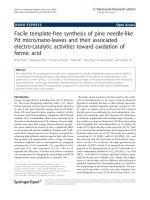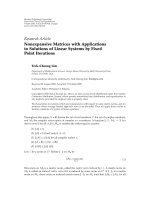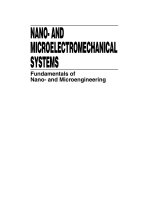Micro nano systems national contact point meeting ICT call 2
Bạn đang xem bản rút gọn của tài liệu. Xem và tải ngay bản đầy đủ của tài liệu tại đây (727.17 KB, 22 trang )
1
Micro/nano systems
National Contact Point Meeting
ICT Call 2
Brussels. 23rd May 2007
Francisco Ibáñez
Microsystems
European Commission
2
Challenge 3:
Components, Systems, Engineering
Objectives
–
ICT-2007.3.1: Next generation nanoelectronics
components and electronics integration
–
ICT-2007.3.2: Organic and large area electronics and
displays
–
ICT-2007.3.3: Embedded systems design
–
ICT-2007.3.4: Computing systems
–
ICT-2007.3.5: Photonic components and subsystems
–
ICT-2007.3.6: Micro/Nanosystems
–
ICT-2007.3.7: Networked embedded and control
systems
Call 1
Call 2
3
Micro/Nanosystems
Micro/nanosystems are miniaturised systems able
to
•
sense, diagnose, describe and qualify a given
situation;
•
suggest or implement appropriate actions;
•
interact with the user, the environment or
another smart systems.
4
Micro/Nanosystems
Features
Interdisciplinarity
Mechanics, electronics, fluidics, biology, magnetism, optics
Convergence
Micro/nano, ICT, bio
Heterogeneity
Semiconductor, ceramic, glass, organic
Multifunctionality
Sensing, processing, logic, memory, comm, energy
Integration
Monolithic, hybrid, multichip, large area
5
ICT-2007.3.6: Micro/Nanosystems
•
Next generation smart systems
Sensor- & actuator-based systems
High density mass storage
•
Micro/Nano-Bio-ICT convergence
Biosensors, lab-on-a-chip, bioMEMS,
autonomous implants
•
Integration of smart materials
Integration of micro-nano technologies and smart systems into new &
traditional materials, e.g. textiles, glass, paper
•
From smart systems to viable products
Microsystems manufacturing technologies
•
Smart systems for communications & data management
Smart micro/nanosystems enabling wireless access & facilitating
intelligent networking
•
Support actions
Technology access, education & training, coordination &
dissemination at EU level
(*)
Courtesy STELLA
Courtesy INTELLIDRUG
6
Micro/nano systems
Indicative Budget*
Total: 83 M€
•
75 M€ Collaborative Projects
–
20 M€ IPs (min.)
–
32 M€ STREPs (min.)
•
4 M€ NoE
•
4 M€ CSA (CA+SA)
*Total amounts to be confirmed after a new financing
decision for the 2008 budget
7
Objective 3.6 (a): Next Generation Smart Systems
Outcome
•
Major breakthroughs in intelligent
sensors and actuators
•
Integrated micro/nanoscale smart
systems (closed-loop)
•
Energy scavenging, storing and
management techniques
•
Design and packaging technologies
•
Integrated systems for very high
density mass storage
Complexity, performance, miniaturisation, autonomy, cost
Courtesy of project INOS
8
Objective 3.6 (b): Nano-Bio-ICTechnologies
convergence
Outcome
•
Converging micro/nano, bio and
information technologies
•
Application areas including
environmental monitoring, agriculture
and food quality, safety, security,
biomedical and lifestyle
•
Address packaging, interfacing, as well
as ethical and societal issues.
Courtesy of project OPTOLABCARD
biosensors, lab-on-chip, biorobots,, nanoimplants, bioMEMS,
microsystems for food, safety, environment
9
Objective 3.6 (c): Integration of Smart Materials
Outcome
•
Integration of micro-nanosystems into
new and traditional materials, e.g.
textiles, glass, paper, etc.
•
Emphasis on SFIT (Smart Fabric
Interactive Textiles) using
micro/nanosystems, microelectronics,
user interfaces, power sources, for
personal wearable applications.
Courtesy of project SHIFT
Biocompatible, bioconnective, flexible, durable materials
10
Objective 3.6 (d): From smart systems to viable
products
Outcome
•
Advanced, cost-effective technologies for
sensor/actuator manufacturing and system
integration
•
Alternative fabrication and testing
processes for low/medium scale volume and
short time-to-market
•
Pre-industrial validation of manufacturing
concepts suitable for large-scale production
Courtesy of project AMICON
Materials, equipment, design, manufacturing, modelling, testing,
reliability
11
Objective 3.6 (e): Smart Systems for communications
and data management
Outcome
•
Micro/nanosystems enabling wireless access
and networking
•
Data management, storage and processing
functions of smart systems
RFID, HF-M/NEMS, data management
12
Objective 3.6 (f): Support actions
Outcome
•
Ensure access to micro/nanosystems
manufacturing technologies, in
particular by SMEs
•
Identify training and education
needs; propose actions
•
Coordination and dissemination of
smart systems integration R&D at
European level
Courtesy of project NANOSPAD
13
Objective 3.3.6: Micro/Nanosystems
Expected Impact
•
Achieve substantial improvement on various aspects of smart
systems integration: Higher product quality and reliability,
increased miniaturisation, integration and functionality,
lower costs, reduced power consumption, higher speed
requirements and/or shorter time-to-market.
•
Provide innovative micro/nanosystems concepts and deeply
transform industrial production by adding intelligence to
process control and the manufacturing shop floor, and by
improving logistics and distribution - thereby increasing
productivity.
•
Contribute to increased market share for European
companies across different industrial sectors by delivering
systems with new functional capabilities and improved
quality within a competitive timeframe.
14
FP7 - ICT PRIORITY
INFORMATION DAY on CALL FOR PROPOSALS 2
OBJECTIVE 3.6 MICRO/NANO SYSTEMS
Tuesday, 29 May 2007
Venue: Charlemagne Building, Lord Jenkins (S2), Brussels
A number of officials from the European Commission will
present the
themes and key information on FP7 proposal submission.
The information day will provide possibility for,
ideas/proposals announcement, interaction on the
spot and partnerships. Afternoon session with 5’
presentation of proposal ideas and expressions of
interest
/>0529_en.html
/>.html
15
Micro/Nanosystems
FP6 (2002-06)
16
Micro/Nanosystems
FP6 (2002-06)
17
Microsystems
FP6 EC Contribution per type of organisation
RES: Research organisations
HE: Higher education or Training
IND: Industrial organisations private or public
OTH: Organisations not fitting in one of the above
categories
18
Projects and EC contribution per type of projects
19
Some more statistics …
CA IP NoE SSA STRP Total
Total number of Projects
5 21 4 6 43 79
Total Project costs (M€)
3.4 312.3 22.8 2.9 165.8 507.2
Total Project EC contribution (M€)
3.4 173.3 20.8 2.9 100.6 301
Average Project costs (M€)
0.68 14.87 5.7 0.48 3.85 6.42
Average EC contribution (M€)
0.68 8.25 5.2 0.48 2.34 3.81
Average Duration (months)
24 42.6 45 31 35.5 36.8
Total number of participants
37 339 82 37 333 828
Average number of participants
7.4 16.1 20.5 6.2 7.7 10.5
20
Experts call
/>•
Call for experts for FP7
•
FP6 experts have been invited* to transfer to
FP7 and to update their CV
(* using the email address in FP6 database!)
•
Nacional contact points can suggest names for
experts in micro/nanosystems
21
For more information
European research on the web:
/> />Information Society and Media:
/> />Directorate G:
22
Micro/Nanosystems
Website:
Website:
http://
http://
cordis.europa.eu/ist/mnd
cordis.europa.eu/ist/mnd
/
/
Contacts:
Contacts:
Thank you!

